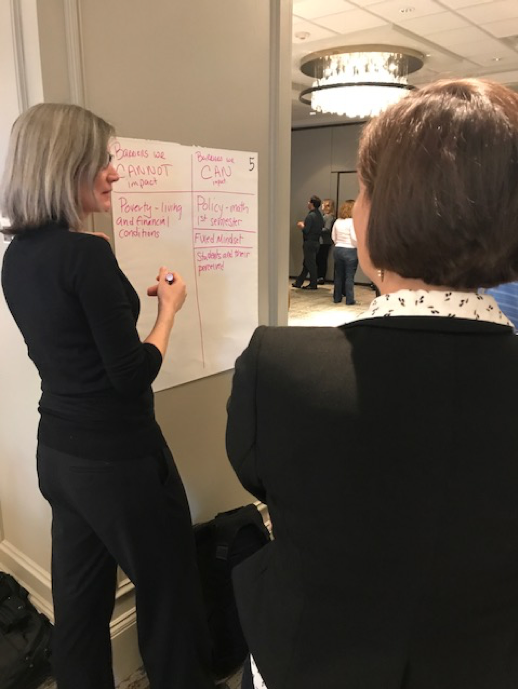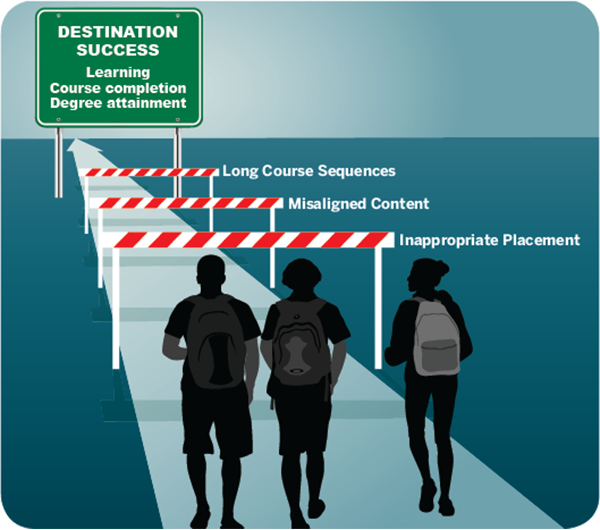For more than six years, the Dana Center Mathematics Pathways (DCMP) has developed the strategies, collaborations, and tools to guide successful implementation of math pathways across the United States.
The DCMP grew out of the collaboration between the Charles A. Dana Center and the Carnegie Foundation for the Advancement of Teaching to develop the Statway™ and Quantway™ programs. This fruitful and productive joint enterprise helped the Dana Center better understand the challenges of implementing math pathways at scale. In particular, Uri Treisman, the executive director of the Dana Center, saw a need for increased attention to policy and coordinated action across an entire system.
The Texas Association of Community Colleges (TACC) stepped forward to work collaboratively with the Dana Center to develop and refine this state–level approach. The Dana Center and TACC launched the New Mathways Project (NMP) in 2011. The reach and impact of the Dana Center Mathematics Pathways model owes much to the leadership and commitment of the many college presidents, faculty, administrators, advisors, institutional researchers, and student support staff in Texas who engaged in this early work.
What are the details?
Expand this section to learn more.
Our state–level work led to a paradigm shift from building pathways around a specific curriculum and course structure to defining pathways guided by a set of organizing principles that allow room for local decision making and customization. This shift led to the development of the DCMP model, which is based on four principles. We at the Dana Center refer to this approach as "coherence without uniformity."
Through the work in Texas, we began expanding our view of whom math pathways should serve. While much of the early work focused on increasing success of developmental students at community colleges, we came to understand that all students would benefit from well–designed math pathways aligned to their programs of study regardless of their placement level or type of institution. This understanding broadened our vision to one in which mathematics pathways are the normative practice across all sectors of higher education.
The Dana Center has always been a strong advocate for math pathways nationwide. In 2013, we formally expanded our work outside of Texas through a collaboration with the state of Georgia. We now have conducted work in nearly 20 states and collaborate with a number of national organizations.

In 2016, the New Mathways Project was rechristened the Dana Center Mathematics Pathways (DCMP) to reflect the changing landscape in which mathematics pathways are no longer a "new" or experimental concept. Mathematics pathways are now widely accepted as a critical component of modernizing undergraduate mathematics education and are sanctioned by mathematics professional associations, policy agencies, and higher education organizations (visit our National Work page for details).
The DCMP is an umbrella for a number of projects and strands of work at the national level and across different states to implement math pathways aligned with the DCMP model. It embraces work across higher education sectors and functions as we seek to provide faculty, staff, administrators, and policy representatives with the resources, tools, and services necessary to implement high–quality mathematics pathways effectively.
A Coordinated Strategy
The Dana Center Mathematics Pathways encompasses many strands of work spanning policy, institutional change, and course design in a coordinated strategy to:
- Build momentum, enthusiasm, and legitimacy for mathematics pathways;
- Identify effective practices for implementation;
- Create enabling conditions for institutions and departments to implement effective practices; and
- Offer tools and resources to support action at all levels of the system.

Are you interested in launching math pathways implementation in your state, system, or institution? Contact us to begin the conversation.




